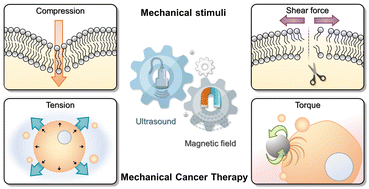Mechanical stimuli-driven cancer therapeutics
Abstract
Mechanical stimulation utilizing deep tissue-penetrating and focusable energy sources, such as ultrasound and magnetic fields, is regarded as an emerging patient-friendly and effective therapeutic strategy to overcome the limitations of conventional cancer therapies based on fundamental external stimuli such as light, heat, electricity, radiation, or microwaves. Recent efforts have suggested that mechanical stimuli-driven cancer therapy (henceforth referred to as “mechanical cancer therapy”) could provide a direct therapeutic effect and intelligent control to augment other anti-cancer systems as a synergistic combinational cancer treatment. This review article highlights the latest advances in mechanical cancer therapy to present a novel perspective on the fundamental principles of ultrasound- and magnetic field-mediated mechanical forces, including compression, tension, shear force, and torque, that can be generated in a cellular microenvironment using mechanical stimuli-activated functional materials. Additionally, this article will shed light on mechanical cancer therapy and inspire future research to pursue the development of ultrasound- and magnetic-field-activated materials and their applications in this field.



 Please wait while we load your content...
Please wait while we load your content...